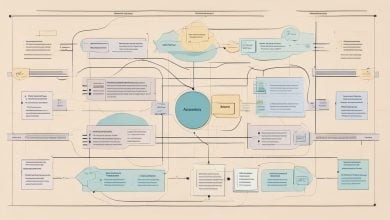Welcome to our guide on harnessing the power of code snippets! As a developer, you know the importance of writing efficient and reusable code to speed up development time. Code snippets are an essential tool in your arsenal for achieving this goal.
Code snippets are small pieces of code that can be reused in multiple projects. They can range from simple functions to more complex algorithms. By using code snippets, you can save time and reduce the risk of errors in your code.
In this guide, we’ll explore the benefits of using code snippets and provide examples of common code snippets. We’ll also discuss strategies for building and maintaining a code snippet library, as well as practical tips and tricks for using code snippets in your everyday programming tasks.
Key Takeaways
- Code snippets are small pieces of code that can be reused in multiple projects.
- By using code snippets, developers can save time and reduce the risk of errors in their code.
- In this guide, we’ll explore the benefits of using code snippets and provide practical tips and tricks for using them effectively.
Understanding Code Snippets: Examples and Best Practices
Code snippets are reusable sections of code that can be easily integrated into different software programs or applications. They are typically small, self-contained, and perform a specific function. Code snippets can be written in various programming languages such as Python, JavaScript, C++, and Ruby, among others. They are an effective tool for speeding up development time, improving code quality, and reducing errors.
Code Snippet Examples
There are many examples of common code snippets that developers use on a regular basis. Some of these include:
| Code Snippet | Description |
|---|---|
console.log() | A debugging tool that logs messages to the browser console. |
for (let i = 0; i < array.length; i++) | A loop that iterates through an array and performs a specific action. |
document.getElementById() | A function that retrieves an HTML element by its ID. |
These examples demonstrate the versatility and reusability of code snippets. They can be used across different projects and can save developers time and effort when writing code from scratch.
Coding Best Practices
There are several best practices that developers should follow when using code snippets:
- Test the code snippet before using it: It’s important to ensure that the code snippet works as intended before integrating it into an application.
- Use descriptive comments: Adding comments to the code snippet can help make it more readable and understandable for other developers.
- Keep the code snippet short: Code snippets should be concise and perform a single function. This makes them easier to understand and maintain.
- Organize code snippets: Storing code snippets in a library or repository can save time and effort when searching for a specific snippet.
By following these best practices, developers can ensure that their code snippets are efficient, maintainable, and reusable.
Building a Code Snippet Library: Organization and Optimization
Building a code snippet library is an essential part of any efficient developer’s workflow. As your codebase grows, having a collection of reusable formulas and functions can significantly speed up your development process. However, keeping track of all your code snippets can be a daunting task without proper organization and optimization.
Code Snippet Organization
The key to maintaining an effective code snippet library is proper organization. A well-structured code snippet library should be easily searchable and allow for intuitive browsing. One way to achieve this is by grouping your snippets into categories based on functionality or programming language. For example, you could create separate folders for HTML/CSS snippets, JavaScript functions, and PHP classes.
Another crucial consideration is naming conventions. Avoid using generic names for your snippets, as this makes it challenging to identify their function. Instead, use descriptive names that summarize the purpose of the code snippet. A good naming convention will enable you to find the appropriate snippet more efficiently and reduce the likelihood of accidentally reusing the wrong code snippet.
Code Snippet Optimization
Optimizing your code snippets not only increases their efficiency but also makes them easier to maintain in the long run. One optimization technique is to eliminate redundancy and consolidate similar snippets into a single, more versatile snippet. This reduces the size of your code snippet library and makes it easier to manage.
It’s also essential to ensure that your code snippets are well-documented. Comments should be added to each snippet to explain the function, input parameters, and expected output. This simplifies the process of updating and debugging your code snippets, especially when collaborating with other developers.
Finally, it’s essential to keep your code snippet library up to date by regularly reviewing and updating your snippets. Outdated code snippets can cause compatibility issues and reduce performance, so eliminate any deprecated snippets and replace them with updated versions.
Streamlining Development with Code Snippets: Tips and Tricks
Using code snippets is a great way to enhance your coding efficiency and streamline development processes. Here are some practical tips and tricks to help you harness the power of code snippets:
- Use descriptive names for your code snippets to make them easy to find and use.
- Create custom shortcuts for frequently used code snippets to save time.
- Use placeholders in your code snippets to make them more flexible. For instance, instead of hard-coding a specific value, use a placeholder that can be easily replaced.
- Share your code snippets with other developers to foster collaboration and save time.
- Use snippets as building blocks to create more complex code constructs, such as functions and classes.
- Regularly review and update your code snippets to ensure they remain relevant and functional.
By incorporating these tips and tricks into your coding workflow, you can take full advantage of the benefits of code snippets and boost your coding productivity.
Remember, the key to efficient coding techniques is to keep your code snippets organized and optimized for maximum effectiveness.
Code Snippet Optimization: Performance and Maintenance
One of the key advantages of using code snippets is their ability to improve the performance and maintainability of your code. By optimizing your snippets, you can make them more efficient, more flexible, and more robust. Here are some tips for optimizing your code snippets:
Write Efficient Code
When writing code snippets, it’s important to focus on efficiency. This not only makes your code faster, but also helps reduce its memory footprint. Some techniques for writing efficient code include:
- Minimizing the use of loops and conditionals: These can slow down your code and make it harder to read.
- Using built-in functions and libraries: These are often optimized for speed, so they can help improve performance.
- Optimizing memory usage: Avoid unnecessary object creation or data duplication to reduce memory footprint.
By following these tips, you can create code snippets that are faster and more efficient, which can make a big difference in your development workflows.
Make Them Reusable
Code snippets are often used repeatedly throughout a project, so it’s important to ensure that they are reusable. This means making them flexible enough to handle different use cases, and providing clear documentation on how to use them. Some strategies for making your code snippets reusable include:
- Using parameters: Add parameters to your code snippets to make them more flexible and adaptable to different situations.
- Following best practices: Use consistent naming conventions, error handling, and formatting to make your code snippets more readable and maintainable.
- Providing documentation: Include clear documentation on how to use your code snippets, so that other developers can easily understand and reuse them throughout the project.
By making your code snippets more reusable, you can save time and improve the consistency of your codebase, thus improving its overall quality.
Test and Debug
Before using your code snippets in production, it’s important to test them thoroughly and debug any issues that arise. This can prevent bugs from spreading throughout your codebase and causing bigger problems down the line. Some strategies for testing and debugging your code snippets include:
- Unit testing: Write unit tests for your code snippets to ensure that they work as intended in different scenarios.
- Manual testing: Test your code snippets manually to ensure that they work well in real-world situations.
- Debugging: Use tools like debuggers or logging statements to identify and fix any issues that arise in your code snippets.
By testing and debugging your code snippets, you can ensure that they are reliable and error-free, which will help improve the overall quality of your project.
Conclusion
In conclusion, harnessing the power of code snippets is a vital tool for developers seeking to optimize their programming workflow. By utilizing code snippets, developers can speed up development time, enhance productivity, and write efficient and reusable code.
As outlined in this developer’s guide, understanding code snippets and incorporating them into a code snippet library is crucial for maximizing their potential. Proper organization and optimization of code snippets can further improve their effectiveness, while advanced techniques and shortcuts can streamline development processes.
We encourage all developers to explore and expand their code snippet libraries to take advantage of this powerful tool. By doing so, developers can become more efficient and effective at their craft, creating better software and driving innovation in the industry.
Thank you for reading this Developer’s Guide to Harnessing the Power of Code Snippets.
FAQ
Q: What are code snippets?
A: Code snippets are small blocks of reusable code that can be easily inserted into a program or script. They are designed to save time and effort by providing ready-made solutions for common programming tasks.
Q: Why should I use code snippets?
A: Code snippets can greatly enhance your productivity as a developer. They allow you to quickly implement tried and tested solutions, saving you from reinventing the wheel. Additionally, code snippets promote consistency and best practices by providing standard code templates.
Q: How do I create my own code snippet library?
A: To create your own code snippet library, start by identifying common programming tasks or functions that you frequently encounter. Write reusable code snippets for these tasks and organize them in a way that makes them easily accessible. You can use code snippet managers or text editors with code snippet support to facilitate the process.
Q: Can I share my code snippet library with others?
A: Absolutely! Sharing your code snippet library with other developers can be a great way to collaborate and contribute to the coding community. You can upload your snippets to code snippet repositories or forums, or simply share them with your colleagues or peers.
Q: How can code snippets help optimize my code?
A: Code snippets can help optimize your code by providing optimized solutions for common programming tasks. By using these snippets, you can avoid writing inefficient or redundant code and improve the overall performance of your programs or scripts.
Q: How do I maintain and update my code snippet library?
A: Regularly reviewing and updating your code snippet library is essential. As programming techniques and best practices evolve, it’s important to ensure that your snippets are up to date. Set aside time for maintenance tasks such as removing deprecated snippets, fixing bugs, and adding new snippets based on your evolving needs.







